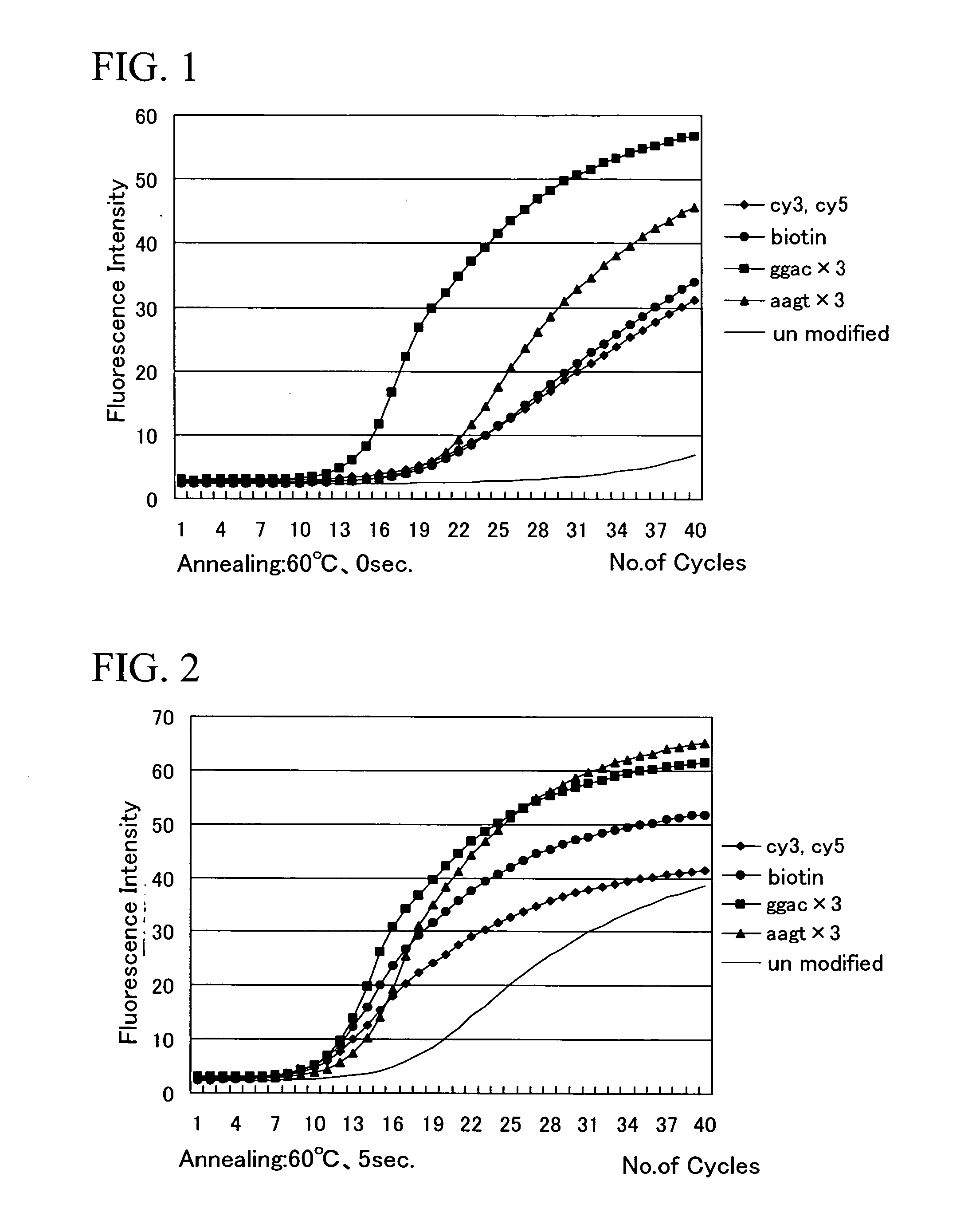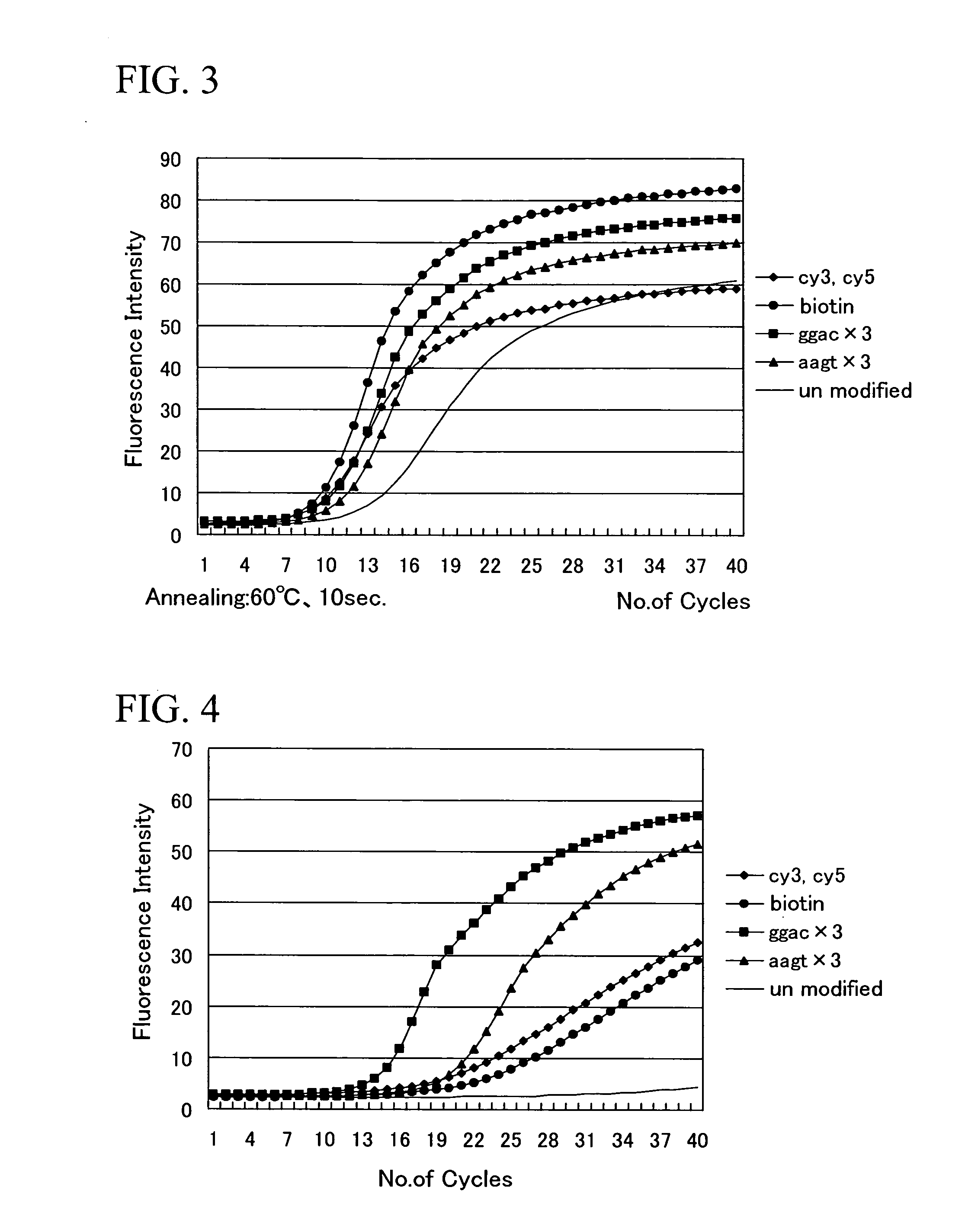Process for amplifying DNA
a technology of amplifying dna and amplifying dna, which is applied in the field of amplifying dna, can solve the problems of sequences including this type of positions that are often unsuitable for primers, sequences that are impractical for primer use, and the efficiency of amplification deterioration, so as to improve the efficiency and specificity of dna amplification, improve the efficiency and specificity of amplification, and simplify the preliminary tests of ann
- Summary
- Abstract
- Description
- Claims
- Application Information
AI Technical Summary
Benefits of technology
Problems solved by technology
Method used
Image
Examples
example 1
Comparison of the Upper Limit Annealing Temperature for Amplification
[0049] Using primers for the detection of Vibrio parahaemolyticus with a compound selected from the specified compounds group conjugated to the 5′ terminus, and utilizing a PCR Express device manufactured by Hybaid Co., Ltd with a Gradient Block Module added, the upper limit annealing temperature for amplification was measured by conducting PCR under the conditions described below.
[0050] The primers for the detection of Vibrio parahaemolyticus utilized a nucleotide sequence represented by the sequence number 1 as the forward side primer and a nucleotide sequence represented by the sequence number 2 as the reverse side primer. [0051] Sequence number 1: aagaagacct agaagatgat [0052] Sequence number 2: gttaccagta atagggca
Each of the compounds of the specified compounds group shown in Table 1 was conjugated to the 5′ termini of the forward side primer and the reverse side primer. In a separate preparation, chromoso...
example 2
Investigation of the Amplification Efficiency in Primers Containing a Compound Selected from the Specified Compounds Group Added to the 5′ Terminus
[0058] A nucleotide sequence represented by the sequence number 1 was used as the forward side primer and a nucleotide sequence represented by the sequence number 2 was used as the reverse side primer. Either cy3, cy5, or biotin, were added (conjugated) to the 5′ termini of the forward side primer and the reverse side primer, and the kinetics of the amplification reaction were analyzed by conducting real time PCR under conditions described below, using a Light Cycler System (manufactured by Roche Diagnostics Co., Ltd.), and using chromosome DNA extracted from a type strain (IFO12711T) of Vibrio parahaemolyticus as a template.
[0059] The PCR conditions were as follows. (1) Denaturation: 1.5 minutes at 95° C. (2) Denaturation: 0 seconds at 95° C. (3) Annealing: 0, 5 or 10 seconds at 60° C., or 5 seconds at 64° C. (4) Extension reaction: 1...
PUM
| Property | Measurement | Unit |
|---|---|---|
| Temperature | aaaaa | aaaaa |
| Temperature | aaaaa | aaaaa |
Abstract
Description
Claims
Application Information
 Login to View More
Login to View More - R&D
- Intellectual Property
- Life Sciences
- Materials
- Tech Scout
- Unparalleled Data Quality
- Higher Quality Content
- 60% Fewer Hallucinations
Browse by: Latest US Patents, China's latest patents, Technical Efficacy Thesaurus, Application Domain, Technology Topic, Popular Technical Reports.
© 2025 PatSnap. All rights reserved.Legal|Privacy policy|Modern Slavery Act Transparency Statement|Sitemap|About US| Contact US: help@patsnap.com


